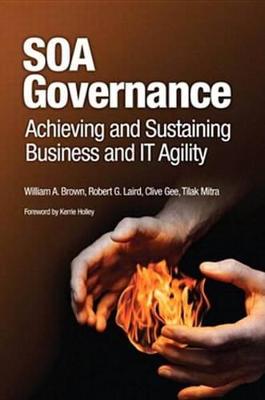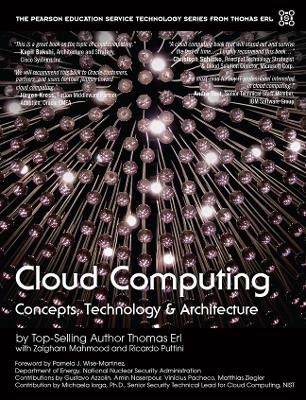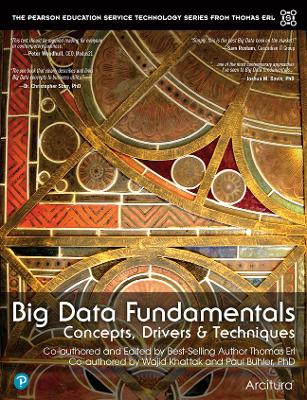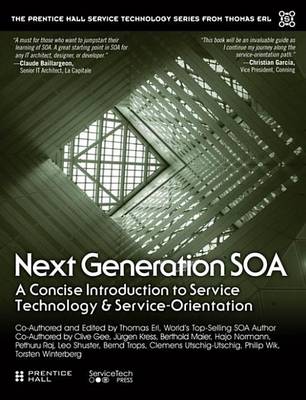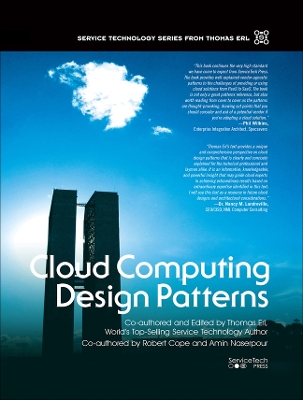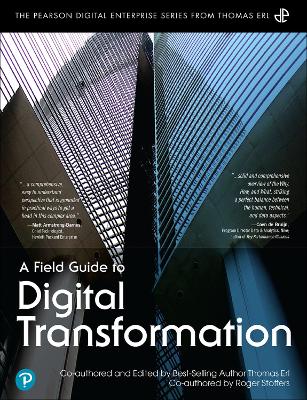The Pearson Service Technology Series from Thomas Erl
9 total works
Inadequate governance might be the most widespread root cause of SOA failure. In SOA Governance, a team of IBM's leading SOA governance experts share hard-won best practices for governing IT in any service-oriented environment.
The authors begin by introducing a comprehensive SOA governance model that has worked in the field. They define what must be governed, identify key stakeholders, and review the relationship of SOA governance to existing governance bodies as well as governance frameworks like COBIT. Next, they walk you through SOA governance assessment and planning, identifying and fixing gaps, setting goals and objectives, and establishing workable roadmaps and governance deliverables. Finally, the authors detail the build-out of the SOA governance model with a case study.
The authors illuminate the unique issues associated with applying IT governance to a services model, including the challenges of compliance auditing when service behavior is inherently unpredictable. They also show why services governance requires a more organizational, business-centric focus than "conventional" IT governance.
Coverage includes
Understanding the problems SOA governance needs to solve
Establishing and governing service production lines that automate SOA development activities
Identifying reusable elements of your existing IT governance model and prioritizing improvements
Establishing SOA authority chains, roles, responsibilities, policies, standards, mechanisms, procedures, and metrics
Implementing service versioning and granularity
Refining SOA governance frameworks to maintain their vitality as business and IT strategies change
Introduction: A Services Approach
Chapter 1: Introduction to Governance
Chapter 2: SOA Governance Assessment and Planning
Chapter 3: Building the Service Factory
Chapter 4: Governing the Service Factory
Chapter 5: Implementing the SOA Governance Model
Chapter 6: Managing the Service Lifecycle
Chapter 7: Governance Vitality
Chapter 8: SOA Governance Case Study
Appendix A: Glossary
Appendix B: References
Index
In Cloud Computing: Concepts, Technology & Architecture, Thomas Erl, one of the world’s top-selling IT authors, teams up with cloud computing experts and researchers to break down proven and mature cloud computing technologies and practices into a series of well-defined concepts, models, technology mechanisms, and technology architectures, all from an industry-centric and vendor-neutral point of view. In doing so, the book establishes concrete, academic coverage with a focus on structure, clarity, and well-defined building blocks for mainstream cloud computing platforms and solutions.
Subsequent to technology-centric coverage, the book proceeds to establish business-centric models and metrics that allow for the financial assessment of cloud-based IT resources and their comparison to those hosted on traditional IT enterprise premises. Also provided are templates and formulas for calculating SLA-related quality-of-service values and numerous explorations of the SaaS, PaaS, and IaaS delivery models.
With more than 260 figures, 29 architectural models, and 20 mechanisms, this indispensable guide provides a comprehensive education of cloud computing essentials that will never leave your side.
--Peter Woodhull, CEO, Modus21
“The one book that clearly describes and links Big Data concepts to business utility.”
--Dr. Christopher Starr, PhD
“Simply, this is the best Big Data book on the market!”
--Sam Rostam, Cascadian IT Group
“...one of the most contemporary approaches I’ve seen to Big Data fundamentals...”
--Joshua M. Davis, PhD
The Definitive Plain-English Guide to Big Data for Business and Technology Professionals
Big Data Fundamentals provides a pragmatic, no-nonsense introduction to Big Data. Best-selling IT author Thomas Erl and his team clearly explain key Big Data concepts, theory and terminology, as well as fundamental technologies and techniques. All coverage is supported with case study examples and numerous simple diagrams.
The authors begin by explaining how Big Data can propel an organization forward by solving a spectrum of previously intractable business problems. Next, they demystify key analysis techniques and technologies and show how a Big Data solution environment can be built and integrated to offer competitive advantages.
- Discovering Big Data’s fundamental concepts and what makes it different from previous forms of data analysis and data science
- Understanding the business motivations and drivers behind Big Data adoption, from operational improvements through innovation
- Planning strategic, business-driven Big Data initiatives
- Addressing considerations such as data management, governance, and security
- Recognizing the 5 “V” characteristics of datasets in Big Data environments: volume, velocity, variety, veracity, and value
- Clarifying Big Data’s relationships with OLTP, OLAP, ETL, data warehouses, and data marts
- Working with Big Data in structured, unstructured, semi-structured, and metadata formats
- Increasing value by integrating Big Data resources with corporate performance monitoring
- Understanding how Big Data leverages distributed and parallel processing
- Using NoSQL and other technologies to meet Big Data’s distinct data processing requirements
- Leveraging statistical approaches of quantitative and qualitative analysis
- Applying computational analysis methods, including machine learning
After a decade of innovation in technology and practice, SOA is now a mainstream computing discipline, capable of transforming IT enterprises and optimizing business automation. In Next Generation SOA, top-selling SOA author Thomas Erl and a team of experts present a plain-English tour of SOA, service-orientation, and the key service technologies being used to build sophisticated contemporary service-oriented solutions. The starting point for today's IT professionals, this concise guide distills the increasingly growing and diverse field of service-oriented architecture and the real-world practice of building powerful service-driven systems. Accessible and jargon-free, this book intentionally avoids technical details to provide easy-to-understand, introductory coverage of the following topics:
- Services, service-orientation, and service-oriented computing: what they are and how they have evolved
- How SOA and service-orientation change businesses and transform IT culture, priorities, and technology decisions
- How services are defined and composed to solve a wide spectrum of business problems
- Deep implications of the service-orientation paradigm--illuminated through an annotation of the classic SOA Manifesto
- Traditional and contemporary service technologies and architectures
- How clouds and virtualization support the scalability and reliability of services-based solutions
- SOA-based industry models, from enterprise service to global trader
- A detailed case study: how real enterprises bring together contemporary SOA practices, models, and technologies
Cloud Computing Design Patterns
by Thomas Erl, Robert Cope, and Amin Naserpour
--Phil Wilkins, Enterprise Integration Architect, Specsavers
“Thomas Erl’s text provides a unique and comprehensive perspective on cloud design patterns that is clearly and concisely explained for the technical professional and layman alike. It is an informative, knowledgeable, and powerful insight that may guide cloud experts in achieving extraordinary results based on extraordinary expertise identified in this text. I will use this text as a resource in future cloud designs and architectural considerations.”
--Dr. Nancy M. Landreville, CEO/CISO, NML Computer Consulting
The Definitive Guide to Cloud Architecture and Design
Best-selling service technology author Thomas Erl has brought together the de facto catalog of design patterns for modern cloud-based architecture and solution design. More than two years in development, this book’s 100+ patterns illustrate proven solutions to common cloud challenges and requirements. Its patterns are supported by rich, visual documentation, including 300+ diagrams.
The authors address topics covering scalability, elasticity, reliability, resiliency, recovery, data management, storage, virtualization, monitoring, provisioning, administration, and much more. Readers will further find detailed coverage of cloud security, from networking and storage safeguards to identity systems, trust assurance, and auditing.
This book’s unprecedented technical depth makes it a must-have resource for every cloud technology architect, solution designer, developer, administrator, and manager.
Topic Areas
- Enabling ubiquitous, on-demand, scalable network access to shared pools of configurable IT resources
- Optimizing multitenant environments to efficiently serve multiple unpredictable consumers
- Using elasticity best practices to scale IT resources transparently and automatically
- Ensuring runtime reliability, operational resiliency, and automated recovery from any failure
- Establishing resilient cloud architectures that act as pillars for enterprise cloud solutions
- Rapidly provisioning cloud storage devices, resources, and data with minimal management effort
- Enabling customers to configure and operate custom virtual networks in SaaS, PaaS, or IaaS environments
- Efficiently provisioning resources, monitoring runtimes, and handling day-to-day administration
- Implementing best-practice security controls for cloud service architectures and cloud storage
- Securing on-premise Internet access, external cloud connections, and scaled VMs
- Protecting cloud services against denial-of-service attacks and traffic hijacking
- Establishing cloud authentication gateways, federated cloud authentication, and cloud key management
- Providing trust attestation services to customers
- Monitoring and independently auditing cloud security
- Solving complex cloud design problems with compound super-patterns
Powerpoints for Cloud Computing
by Thomas Erl, Ricardo Puttini, and Zaigham Mahmood
A Field Guide to Digital Transformation is the definitive book on digital transformation. Top-selling IT author Thomas Erl and long-time practitioner Roger Stoffers combine to provide comprehensive, yet easy-to-understand coverage of essential digital transformation concepts, practices, and technologies in the format of a plain-English tutorial written for any IT professionals, students, or decision-makers.
With more than 160 diagrams, this guide provides a highly visual exploration of what digital transformation is, how it works, and the techniques and technologies required to successfully build modern-day digital transformation solutions.
Learn from the experts and:
- Discover what digital transformation is, why it emerged and when to apply it
- Identify the significant business benefits that successful digital transformations can deliver and how to turn your organization into a “disruptive” force
- Prepare for and overcome the common challenges associated with digital transformation initiatives
- Understand the data-driven nature of digital transformation solutions and how they use and continually accumulate data intelligence
- Understand how digital transformation solutions can utilize AI technology for intelligent automated decision-making
- Gain insight into customer-centricity and how its practices are applied as part of digital transformations
- Explore key digital transformation automation technologies, such as Robotic Process Automation (RPA), Internet of Things (IoT), Blockchain. and Cloud Computing
- Explore key digital transformation data science technologies, such as Artificial Intelligence (AI), Machine Learning, and Big Data Analysis and Analytics
The book concludes with a uniquely detailed and highly visual real-world business scenario that provides step-by-step insights into how a digital transformation solution works, how it utilizes data intelligence to improve customer relationship building, and how it collects new data intelligence in support of enhancing future business capabilities.
